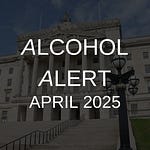Hello and welcome to the Alcohol Alert, brought to you by The Institute of Alcohol Studies.
In this edition:
IAS blogs
Two PhD projects to understand women’s drinking open for application, funded by SARG and IAS
£27.4 billion cost of alcohol harm in England every year 🎵 podcast feature 🎵
The government is failing to tackle record-high alcohol-related deaths
Prevention inquiry session highlights evidence around population-level policies
Alibi marketing, surrogate marketing, or brand sharing?
Handle with care: The need for responsible alcohol delivery
Children’s exposure to alcohol advertising on TV declines
Alcohol Toolkit Study: update
We hope you enjoy our roundup of stories below: please feel free to share. Thank you.
IAS blogs
To read blogs click here.
Two PhD projects to understand women’s drinking open for application, funded by SARG and IAS
The Sheffield Addictions Research Group (SARG) has posted two PhD proposals which will be funded and run by SARG, and part-funded by IAS. Both projects will focus on women’s drinking.
Proposal 1: What’s happening with women’s drinking? Understanding gender inequalities in alcohol consumption and harm in England
The gap between men and women’s drinking has been closing for years and alcohol deaths among women have risen faster.
We do not have a clear understanding of how the overall harm profile of alcohol differs between men and women and how these differences may have changed over time.
The project will use a wide range of survey, market research, and epidemiological data to understand trends and patterns in women’s drinking in recent decades.
Proposal 2: A qualitative investigation of the connections between changes in women’s alcohol consumption and their participation in heavy drinking professions
At the same time as women’s drinking has risen, women have entered in large numbers professions previously dominated by men, with cultures of heavy drinking.
We have limited understanding of how this entry has interacted with women’s drinking.
The project will investigate how women experience and negotiate the drinking cultures of different professions.
£27.4 billion cost of alcohol harm in England every year 🎵 podcast feature 🎵
Alcohol harm costs England £27.4 billion a year, new research by IAS has found.
The research is the first analysis of its kind in over 20 years, when the Cabinet Office estimated the cost in 2003. The findings have been published on a new Economy section of our website, along with relevant stats, FAQs, briefings, publications, blogs, and podcasts.
Tax revenue from alcohol only raises around £12.5 billion each year, meaning it is dwarfed by the financial cost of harm.
The economic burden on the NHS now stands at £4.9 billion, enough to pay for the salaries of almost half the nurses in England.
“Year after year, we have seen steady increases in alcohol consumption, and deaths are at a record high”, said Dr Katherine Severi, IAS’s Chief Executive. “Now we have data to show that the financial cost of harm has risen too. As a country we cannot afford to sit back and do nothing. The government should develop a comprehensive alcohol strategy to tackle this rising harm, which would have a knock-on effect of reducing the financial burden too.”
For two decades the most authoritative estimate of the total cost of alcohol harm came from a 2003 study by the Cabinet Office. Growing frustration over the government’s failure to update this figure led to the Public Accounts Committee stating last year that the lack of an up-to-date estimate meant the government was “not even in a position to identify an appropriate response” to alcohol harm. IAS uses the same Cabinet Office methodology and breaks the total cost into the following categories:
£4.91 billion cost to the NHS and healthcare in England – such as hospital admissions and ambulance call-outs.
£14.58 billion cost to the criminal justice system, police, and wider crime and disorder.
£5.06 billion cost to the wider economy due to lost productivity – such as people missing work or being less productive at work.
£2.89 billion cost to social services.
TOTAL COST = £27.44bn
The cost of alcohol is notoriously difficult to calculate, partly due to the wide-reaching harm alcohol causes. A 2017 article in Addiction by Dr Aveek Bhattacharya explains these difficulties, while highlighting the importance of understanding the estimated cost.
The figure reflects the ‘external’ cost of alcohol, demonstrating the scale of the harm drinkers impose on others. Across the population, the average cost per head of alcohol harm is £485 a year.
The region with the highest cost per head of alcohol harm was the North East, with every person contributing £562 a year. Susan Taylor, Head of Alcohol Policy at the regional alcohol office Balance, said:
“The North East suffers the worst alcohol harms in the country – and this impact is rising year on year for our people, our streets, our health and our economy. We need real action urgently to tackle this alcohol crisis and ensure that the prosperity of our region isn’t further compromised in the future.”
Liver doctor and Chair of the Alcohol Health Alliance, Professor Sir Ian Gilmore, said:
“This data is published on the same day the Health and Social Care Select Committee is hearing evidence from health experts about how to prevent alcohol harm. Doctors, nurses and other healthcare professionals spend so much of their time treating alcohol-related harms, all of which are preventable. And with the NHS as stretched as it is, it is increasingly important that staff time is dedicated to unavoidable harms. But so much of the UK’s policymaking is in thrall to Big Alcohol, which overplays its economic contribution while underplaying the massive cost of harm. A truly responsible government would understand that tackling alcohol harm should hold primacy over the industry making money for its shareholders.”
A spokesman for the Department of Health said:
“Through our 10-year drug strategy, supported by £532 million, we are helping up to 54,500 more people receive alcohol and drug support, and we are also funding specialist alcohol care teams in hospitals in England with the highest rates of alcohol harm and socio-economic deprivation.
“Last August, the Government also introduced reforms to alcohol duty – meaning products are taxed directly in proportion to their alcohol content, and we are reviewing the official cost of alcohol harm estimates to support us in our efforts to address the harms associated with alcohol.”
In response to the shocking new figures, IAS has called on the government to reflect on the overwhelming evidence base regarding how to reduce alcohol consumption and harm, which would help reduce its economic burden. The measures they have called for include: tackling the increasing affordability of alcohol by introducing Minimum Unit Pricing and raising alcohol duty; restricting alcohol marketing, to protect children and vulnerable groups; and empowering local leaders to control the availability of alcohol in areas with high rates of harm.
On BBC Radio 4’s Today programme on 20 May Dr Severi spoke to Amol Rajan about the findings.
The story was covered by The Guardian, The Telegraph, Daily Mail, Independent, Metro, Evening Standard, as well as many regional titles.
The government is failing to tackle record-high alcohol-related deaths
In an opinion piece in The House magazine, Labour MP Dan Carden wrote that year after year he has seen government inertia simply allow deaths from alcohol to rise to record levels.
“Decades of research have found that there are three powerful ways that governments can reduce alcohol harm: reduce how affordable, available, and appealing alcohol is. However, the government is doing precisely the opposite.
“The Chancellor has frozen alcohol duties once again, meaning duty has been frozen at almost every Budget in the last decade. Making alcohol more or less affordable is a political decision between either supporting the health of our people or supporting a multinational alcohol industry.”
Mr Carden said that if Labour succeeds in forming a government this summer, it has “an exciting opportunity to demonstrate the crucial importance of prevention policies”.
“A positive and evidence-based approach will help bolster Labour’s fiscal prudence by supporting long-term productivity and reducing the exorbitant cost that alcohol places on our NHS, emergency services, and criminal justice system. But ultimately, and more importantly, it will save the lives of thousands of people across the UK, preventing people losing their loved ones far before their time.”
In related news, Public Health Minister Andrea Leadsom responded to a written question regarding the merits of an alcohol strategy by stating that:
“The Government takes a wide-ranging approach to addressing alcohol-related harms, including through taking forward the commitments set out in Advancing our health: prevention in the 2020s, to increase the availability of no- and low-alcohol alternatives, establish alcohol care teams in the 25% of acute hospitals in England with the greatest need as part of the NHS Long Term Plan, and improve the alcohol and drug treatment system through the 10-year Drug Strategy.”
This highlights Mr Carden’s point that upstream prevention policies have been neglected by this government.
Prevention inquiry session highlights evidence around population-level policies
The Health and Social Care Select Committee held a second evidence session for its alcohol harm prevention inquiry, hearing from public health experts Professor Sir Ian Gilmore (AHA and BMA), Alice Wiseman (Director of Public Health), and Ailsa Rutter (Director of Fresh and Balance). You can watch the session back here and read the transcript here.
Two days later, Prime Minister Rishi Sunak announced that a General Election will be held on 04 July 2024, with parliament dissolving on 30 May. This means that there will not be time for the Committee to write its report on the inquiry. Written submissions and transcripts from this session and the previous session – which heard from the alcohol industry – will remain available to the incoming committee, for if they wish to continue the work.
The witnesses highlighted the importance of population-level measures to tackle the affordability, availability, and promotion of alcohol.
A session with broadcaster Adrian Chiles followed, where he discussed his changing attitude to drinking. The Daily Mail published about his session, quoting him as saying that “Drinking mainly, it’s boring. It makes you boring, and it becomes boring if you do too much of it.”
We have shared several clips from the recent session on our Twitter account, for those wanting key takeaways, including:
"We wouldn't have people that are selling [illegal] drugs sat around the table developing our policies. There's something about thinking about alcohol producers in the same way." – Alice Wiseman highlights the conflict of interest at the heart of industry involvement in policy.
Sir Ian and Ailsa drew attention to a number of population-level policies:
"Like Minimum Unit Pricing, tackling alcohol advertising is not a magic bullet" but we need to "look hard" at countries that have tackled it and saw reductions in harm. - Professor Sir Ian Gilmore told the Committee.
"There are some minimal things we should be doing like mandatory labelling. There is no information on the bottles, unlike the very clear information we have on cigarettes. And the public want to know. They want the truth.” - Ailsa Rutter.
Last year, Sir Chris Wormald - Permanent Secretary at DHSC told the Public Accounts Committee that the results of MUP were unclear. Sir Ian told the Committee that they were "perhaps unclear to him" and that the assessment of MUP has been gold standard and given a clear answer.
Finally, Sir Ian countered an industry argument that alcohol harm only affects a minority of people:
"We're not talking about something that just affects a few people in society, there's hardly a family that hasn't been touched by alcohol harm."
Alibi marketing, surrogate marketing, or brand sharing?
Dr Nathan Critchlow, Professor John Holmes, and Professor Niamh Fitzgerald write that researchers and policymakers need to avoid conflating subclasses of alcohol marketing, particularly ‘alibi marketing’ and the marketing for core-branded alcohol-free and low-alcohol products.
They explain that alibi marketing “has roots in how tobacco companies sought to circumvent statutory restrictions on marketing” and that alcohol companies have been shown to use this to circumvent France’s Évin law on alcohol marketing. This form of marketing does not refer to the core brand name, but involves key components of the brand, such as the colours, fonts and slogans. For instance, Carlsberg's ‘Probably… the best in the world’ marketing during the 2016 Euro football tournament and Guinness's ‘Greatness’ branding during the rugby Six Nations.
Conversely, a key component of alcohol-free and low-alcohol product marketing and branding is the use of the core brand name. For instance, Guinness 0.0 or Heineken 0.0. The authors argue that this should be referred to as ‘surrogate marketing’ or ‘brand sharing’, to avoid conflation of the two types of marketing.
They make the point that alibi marketing is an attempt to market regular strength products, whereas ‘surrogate marketing’ or ‘brand sharing’ promotes the variant explicitly mentioned, “even if it may also indirectly promote the regular strength product”.
The authors write that understanding this difference has important policy implications, as countries that have implemented alcohol marketing restrictions – such as Norway, France, and Ireland – have very different approaches due to different terminologies. Policy development needs to be very clear in what it is restricting, and being clear on terminology is an important first step.
Handle with care: The need for responsible alcohol delivery
A new survey commissioned by Alcohol Change UK shows that more needs to be done by apps, online shops, and delivery companies to take better care of the customers using their services when delivering alcohol.
The survey explored the experiences and views of UK adults who regularly use alcohol delivery services (at least once a month for the previous three months).
Their findings show that:
The charity has made recommendations to reduce harms related to alcohol delivery that include age verification, restrictions on delivery platform marketing, updating licensing laws, and training for delivery drivers.
Children’s exposure to alcohol advertising on TV declines
The Advertising Standards Authority – which co-regulates alcohol advertising in print, on TV, outdoor ads, and online – has published a report that states that: “children’s exposure to gambling and alcohol ads on TV continues to decrease”. Children are defined in the Code as those aged 15 and under.
The report indicates that between 2010 and 2023, children’s exposure to alcohol advertising on TV reduced from an average of 3.2 ads per week to 0.7 ads per week.
Exposure to gambling and HFSS product ads also fell in this time period, from 3.0 to 1.8 and 12.4 to 4.4 per week respectively.
These falls will be partly explained by significant falls in the amount of TV that children watch, as the following ASA chart shows.
Many public health advocates would argue that any exposure to harmful commodity advertising is unacceptable, and that exposure online is the more opaque and risky area. To this latter point, the ASA report states that: “we know that a lot of that [fall in exposure] is down to changing media habits, which is why we are also continuing to conduct proactive project work looking at what ads [children] are seeing online.”
Alcohol Toolkit Study: update
The monthly data collected is from English households and began in March 2014. Each month involves a new representative sample of approximately 1,700 adults aged 16 and over.
See more data on the project website here.
Prevalence of increasing and higher risk drinking (AUDIT-C)
Increasing and higher risk drinking defined as those scoring >4 AUDIT-C. A-C1: Professional to clerical occupation C2-E: Manual occupation
Currently trying to restrict consumption
A-C1: Professional to clerical occupation C2-E: Manual occupation; Question: Are you currently trying to restrict your alcohol consumption e.g. by drinking less, choosing lower strength alcohol or using smaller glasses? Are you currently trying to restrict your alcohol consumption e.g. by drinking less, choosing lower strength alcohol or using smaller glasses?
Serious past-year attempts to cut down or stop
Question 1: How many attempts to restrict your alcohol consumption have you made in the last 12 months (e.g. by drinking less, choosing lower strength alcohol or using smaller glasses)? Please include all attempts you have made in the last 12 months, whether or not they were successful, AND any attempt that you are currently making. Q2: During your most recent attempt to restrict your alcohol consumption, was it a serious attempt to cut down on your drinking permanently? A-C1: Professional to clerical occupation C2-E: Manual occupation
The UK Alcohol Alert (incorporating Alliance News) is designed and produced by The Institute of Alcohol Studies. Please click the image below to visit our website and find out more about us and what we do, or the ‘Contact us’ button. Thank you.






















